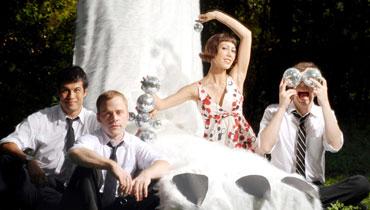The Octopus Project's 8-Speaker Live Surround-Sound System

(Above: Photo by Aubrey Edwards)
As reported in our June/July/August issue, the instrumental electronic-pop quartet known as The Octopus Project (theoctopusproject.com) capitalized on the South by Southwest Music Festival (SXSW) being held in their hometown of Austin, Texas, by staging a live surround-sound performance heard through 8 speakers (and illustrated by 4 video projections).
Each band member - Toto Miranda, Ryan Figg, Yvonne Lambert, and Josh Lambert (in photo, left to right) - is a multi-instrumentalist, and they "all definitely had a hand in the ideas" for the surround presentation, said Josh. But he and Toto did "most of the grunt work" for the mix.
How exactly did they do it?
Josh: "We had two setups going: the Bend Matrix controller and an Ableton Live sequencer. They were governing both live and sequenced elements. I was mostly in charge of making the Bend Matrix do its thing, and Toto was mostly in charge of running the Ableton Live setup.
"Both setups have their strengths and weaknesses, so we really tried to play each one to its fullest. The Bend Matrix is great for sending stuff out in a very choppy way. It either sends the sounds to a speaker or it doesn't - terrible for subtle movements but completely amazing for rhythmic jumps! The Ableton Live is exactly the opposite: It's perfect for having things move around in a very gradual way.
"The Bend Matrix has 8 inputs and 8 outputs that can be programmed in any sequence you can think of. I was using it mostly to send stuff moving in a circle, one track at a time - such as keyboards, guitar, and the prerecorded tracks between songs. But it really got to shine when we ran a sampler with a looped ahhhh sound into one input that was Ping-Ponging from side to side; we also ran a keyboard into a rhythmic sequence, and another step in the sequence was controlling a different sampler via MIDI. All of that was, in turn, synced up with the Ableton Live setup, in which Toto was triggering samples on the fly. Kinda nuts!"
Toto: "On the Ableton Live side of things, we used 8 aux channels in the software, each routed to an output from a FireWire audio interface. Then I'd program dummy clips that controlled envelopes for those 8 channels. This way, we could send live or sequenced audio into the Ableton and change the surround movement throughout a song by triggering different dummy clips - using all the sound-motion ideas Josh was talking about.
- Log in or register to post comments




















































